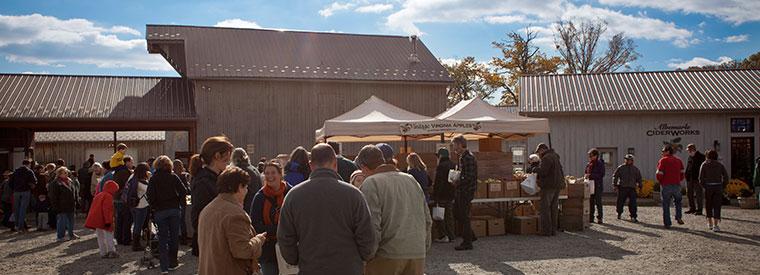
BURDETT, N.Y. — The beauty of cider lies in its simplicity: You pick apples, you grind them up, you press them, then you ferment the juice; after the fermented juice rests for a while, you bottle it. So whether apples are harvested from an orchard or foraged from the wild, if you want to make cider, at some point, the fruit ends up in a press.
...
In fact, cider can often be just as complex as wine. Grapes are to wine what apples are to cider. But cider is also not like wine, in that it usually hails from more humble origins, places like the Catskills or the Green Mountains, or the Berkshires — not Tuscany or Burgundy or Santorini. Cider comes from places where your relatives possibly live or might be the hometown of a friend or where you once went to summer camp or drove through on a family car trip.
Which is why, over the years, I’ve always advocated for American cider as the perfect pairing for Thanksgiving dinner. I’m guessing that that advocacy has generally fallen on deaf ears. But with the recent rise of single-orchard and even single-varietal cider bottlings, I’m making my pitch once again that cider belongs on your Thanksgiving table.
“The smart wine snobs are starting to pay attention,” says Sam Fitz, owner of Anxo, the District’s urban cidery. Anxo’s flagship cider is a single-variety bottling made from Gold Rush apples. They also recently released Commonwealth, a single-orchard cider featuring the famed Harrison apple.
I’d first tasted Harrison at Albemarle CiderWorks in North Garden, Va. As I researched a book about cider, I found that people around the country often forget about Virginia — particularly Albemarle County — as one of the great cider regions in the nation. In addition to Albemarle CiderWorks, a number of very good cideries are in the county surrounding Charlottesville, such as Castle Hill Cider and Potter’s Craft Cider. A number of distinct cider apples are grown there — including Black Twig, Arkansas Black and Hewe’s Virginia Crab — and a true cider terroir is emerging.

But the Harrison apple has begun to take center stage in Virginia. The apple first appeared in early 19th-century New Jersey, and the prized cider made from it was once called “Newark Champagne.” The noted pomologist William Coxe wrote, in 1817, of Harrison’s “high coloured, rich, and sweet cider of great strength, commanding a high price in New York, frequently ten dollars and upwards per barrel when fined for bottling.” But by the mid-20th century, the Harrison had disappeared, thought to be extinct. Then, in 1976, an orchardist named Paul Gidez used Coxe’s 19th-century description to track down a single Harrison tree at an old cider mill in Livingston, N.J.
Tom Burford, an author and fruit historian who is also orchard consultant at Albemarle, helped verify its identity. In a 2010 interview with Edible Jersey magazine, Burford called Harrison “the most enigmatic apple I’ve ever dealt with. When I first tasted it, I had to sit down. I was so unsettled. How could it have happened that this great cider apple got pushed out of production?” Harrison is now grown mostly in Virginia.
.....
Read More from the Washington Post article HERE.

